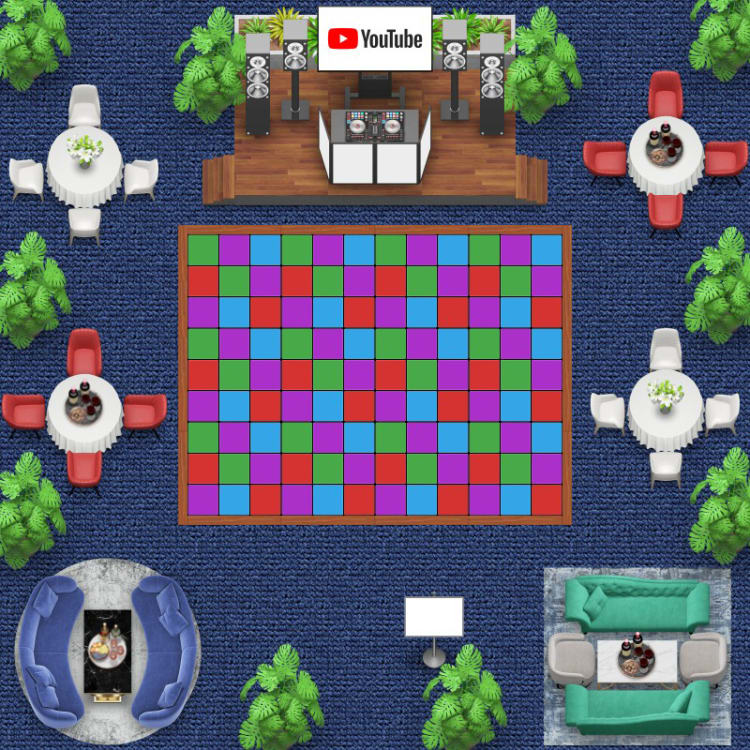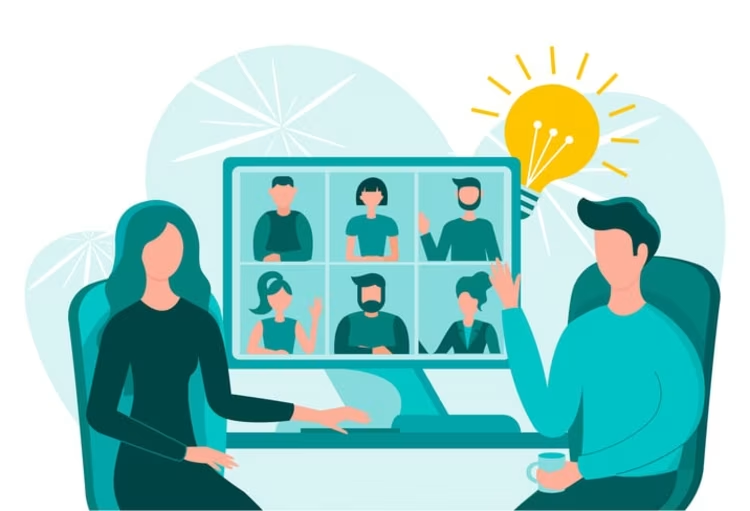Are you looking to boost collaboration, communication, and overall team spirit within your remote team? Look no further! Virtual team building activities offer numerous benefits, ranging from increased productivity to fostering a strong remote work culture. In this blog post, we’ll dive into the importance of virtual team building, creative activities to engage your team, adapting traditional team building activities for a virtual setting, and best practices for successful virtual team building.
Key Takeaways
- Virtual team building activities are key for remote teams to foster relationships, improve communication & boost morale.
- Creative virtual activities promote skill development, wellness and social connection among employees.
- Encourage participation with incentives & measure success through feedback to ensure successful outcomes!
The importance of virtual team building

The proliferation of remote work has made virtual team building a crucial element in sustaining a vibrant company culture and keeping employees involved. These activities not only help to create a strong remote work culture, but also enhance communication and boost employee morale.
Confronted with challenges including isolation, communication barriers, and scarce team bonding, remote teams can use virtual team building activities as an effective method for remote team building, promoting a sense of inclusion.
Benefits of virtual team building
Engaging in virtual team building activities offers a wealth of benefits. Some of these benefits include:
- Boosting productivity, satisfaction, and collaboration among remote team members
- Encouraging creative thinking and problem-solving skills
- Improving critical thinking skills
By participating in virtual team challenges, each team member is able to work together with other team members to solve problems and develop important skills that can benefit the entire team.
Virtual icebreaker games, for example, can help break down communication barriers and create a sense of camaraderie and team spirit during virtual meetings. This can lead to more open and honest communication among team members, ultimately resulting in stronger working relationships. Additionally, activities such as the Recipe Roundup or Bookclub can strengthen communication skills while providing a fun and engaging experience for team members.
Moreover, virtual team building activities play a pivotal role in fostering a positive organizational culture. When employees feel engaged and connected to their colleagues, they are more likely to feel satisfied in their roles and have a stronger sense of loyalty to the company. As a result, virtual team building activities can help to create a positive work environment, ultimately leading to higher employee retention rates and overall success for the company.
Challenges faced by remote teams

Remote teams often face unique challenges that can make it difficult to maintain strong working relationships and a positive company culture. One such challenge is the lack of face-to-face interaction, which can lead to communication barriers and a sense of isolation among team members. Additionally, remote workers may struggle to maintain a healthy work-life balance, leading to burnout and decreased job satisfaction.
Nevertheless, virtual team building activities can mitigate these challenges by cultivating relationships, improving communication, and increasing motivation among remote teams. By engaging in activities such as virtual scavenger hunts, virtual escape rooms, and virtual trivia nights, remote team members can come together, collaborate, and have fun, ultimately leading to a stronger sense of connection and team spirit.
Creative virtual team building activities

There is no shortage of innovative and engaging virtual team building activities to suit the diverse needs and preferences of remote teams. From skill development and wellness activities to social connection games, there’s something for everyone to enjoy and benefit from.
Here are some thrilling virtual team building activities that can bolster your team’s growth and success.
Skill development activities
Skill development activities are an excellent way to enhance specific skills such as problem-solving, critical thinking, and communication among remote team members. For example, engaging in virtual team building games like Virtual Trash Challenge or Spreadsheet Wars can help improve problem-solving skills, while participating in activities like the Language Class can strengthen communication skills among team members.
Another great skill development activity is the Dog, Rice, and Chicken game, which is designed to inspire creative thinking and sharpen problem-solving skills. By participating in these activities, remote team members can not only have fun and bond with each other, but also develop essential skills that can contribute to the overall success of the team.
Wellness and mindfulness activities
Promotion of mental and emotional well-being among remote team members is key to sustaining a balanced work-life scenario and managing stress. Wellness and mindfulness activities can help remote workers manage their stress levels and maintain a positive mindset. For example, the Online Fitness Club virtual team building activity encourages team members to reach their fitness goals together, while the Offline Employee Wellness/Fitness Challenge provides daily workouts and objectives to help team members stay healthy and focused.
Another great wellness activity is the Niagara Falls (Water Challenge), which encourages team members to drink more water and promote healthy living. By participating in these activities, remote team members can not only take care of their physical health, but also foster a sense of camaraderie and support among their colleagues.
Social connection activities

Cultivating social connections among remote team members is vital to instilling a sense of inclusion and team spirit. Engaging in fun and interactive team building activities like Pictionary, virtual escape rooms, or virtual cooking classes can help remote teams bond and socialize, ultimately leading to stronger working relationships.
Another great social connection activity is the Virtual Dance Party, which brings everyone together for a fun and energetic experience. By participating in these activities, remote team members can not only have fun and unwind, but also build meaningful connections with their colleagues, leading to a more cohesive and successful team.
Kumospace is the leading virtual events and workspace platform for hybrid and remote teams. This immersive video chat experience allow users to interact in a virtual environment. One of the popular team building templates is Disco Club.
Adapting traditional team building activities for a virtual setting
As remote work becomes more commonplace, it is imperative to find ways to modify traditional team building activities for a virtual environment. By modifying in-person activities to suit remote teams and making use of technology and online platforms, remote teams can still experience the benefits of team building events without being physically present together.
Team building activities can help remote teams build trust, foster collaboration, and create a sense of belonging.
Adapting in-person games
Transforming classic team building games into engaging virtual activities for remote teams is a creative and effective way to maintain team spirit and camaraderie. Activities such as virtual scavenger hunts, virtual escape rooms, and virtual trivia nights can be adapted from their in-person counterparts to provide a fun and engaging experience for remote team members. Here are 15 virtual games ready to play inside Kumospace.
Adapting in-person games for virtual teams not only allows remote team members to participate in team building events, but also fosters a sense of belonging and unity among remote workers. By leveraging technology and customizing the rules and objectives of the games to fit the virtual setting, remote teams can enjoy the same benefits of team building events as their in-person counterparts, including engaging in online office games.
Utilizing technology for virtual team building
Technology serves as a vital conduit in enabling effective virtual team building activities. Tools, apps, and software such as video conferencing platforms, online gaming platforms, and digital collaboration tools can be used to create immersive and interactive experiences for remote team members.
For example, video conferencing platforms like Kumospace, Zoom, Microsoft Teams, and Google Meet can be used to host virtual team building events, while online gaming platforms can help recreate the excitement of in-person games in a virtual setting. By leveraging these technologies, remote teams can stay connected and engaged, ultimately leading to a more cohesive and successful team.
Tips for successful virtual team building

To guarantee the success of virtual team building activities, adherence to best practices and recommendations is of great importance. From scheduling and time management to encouraging participation and engagement, these tips can help maximize the positive outcomes of virtual team building events.
When scheduling virtual team building activities, it’s important to consider the time zone differences.
Scheduling and time management
In the planning stages of virtual team building activities, considerations such as time zones and work schedules are vital to ensure the highest participation in the team meeting. Clear expectations and timelines should be set, and regular updates should be provided to keep everyone informed about the progress of the activities.
Regularly reviewing and adjusting schedules can also help remote teams stay on track and complete tasks on time, ultimately leading to better collaboration and overall success. By effectively managing time and ensuring that all team members can participate in activities, remote teams can reap the benefits of virtual team building events.
Encouraging participation and engagement
To instill a sense of belonging and unity among remote team members, it’s imperative to stimulate participation and engagement in virtual team building activities. This can be achieved by providing incentives, creating a safe space for open dialogue, and recognizing individual contributions.
By encouraging team members to actively participate in a virtual team building event, these events can not only strengthen their working relationships, but also improve overall team performance and productivity for remote teams.
Measuring success and gathering feedback
Evaluating the effectiveness of virtual team building activities and collecting insightful feedback from team members is paramount for ongoing improvement. Setting measurable goals, tracking progress, and providing feedback can help remote teams evaluate the success of their activities and make positive changes.
By regularly reviewing and analyzing feedback and data, remote teams can gain insight into the impact of virtual team building activities and make adjustments as needed to ensure ongoing success.
Summary
In conclusion, virtual team building activities offer a valuable opportunity for remote teams to enhance communication, boost morale, and foster a strong company culture. By engaging in a variety of creative activities, adapting traditional team building events for a virtual setting, and following best practices for planning and execution, remote teams can experience the numerous benefits of virtual team building. So why not give it a try and witness the positive impact it can have on your team?
Frequently Asked Questions
The seven key drivers of team building, according to Tannenbaum and Salas (2020), are capability, cooperation, coordination, communication, cognition, coaching, and conditions.
Boost collaboration and camaraderie among your virtual team by creating a social space, picking the right tools, introducing effective communication tools, setting up flexible working hours, and prioritizing training.
Try out different activities like icebreakers, virtual campfires, group fitness classes, virtual scavenger hunts, personality assessments, and lunch & learn sessions to further build teamwork remotely.
Get creative with virtual team building activities like virtual scavenger hunts, virtual escape rooms, and virtual trivia nights that help build skills, encourage wellness and mindfulness, and foster social connections.
Engaging in virtual team building activities has numerous benefits, such as increased productivity and satisfaction, improved communication and collaboration among remote team members, and a stronger company culture.





